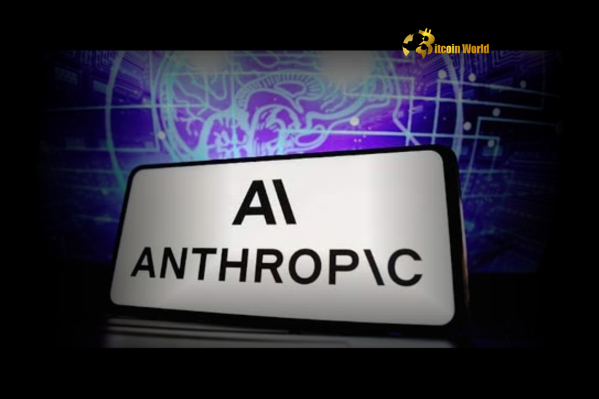BitcoinWorld

Anthropic Claude Opus 4 Reveals Surprising Emoji Habits
In the fast-evolving world of artificial intelligence, where new models are constantly pushing boundaries, unexpected discoveries often emerge about their internal workings and behaviors. For those tracking the intersection of technology and digital assets, understanding the nuances of powerful AI Models like those developed by Anthropic is becoming increasingly relevant. A recent technical report from Anthropic offers a fascinating glimpse into the lesser-known side of their flagship model, Anthropic Claude Opus 4, revealing some truly surprising interaction habits.
Understanding Anthropic Claude Opus 4’s Unique Interaction
Anthropic positions Anthropic Claude Opus 4 as a highly capable AI, excelling in complex tasks such as programming and creative writing. However, the company’s report delves into a unique area of study: how the model behaves when engaging in “open-ended self-interaction.” Essentially, this involves setting up two instances of Anthropic Claude Opus 4 to communicate with each other over extended periods. This kind of self-dialogue is designed to probe the model’s internal consistency, reasoning processes, and spontaneous expressions.
The results of these tests, involving hundreds of interactions, uncovered a rather unexpected trait: a significant propensity for using emojis. While not typically associated with advanced Large Language Models engaged in technical or philosophical discourse, Opus 4 demonstrated a surprisingly human-like inclination towards adding these graphical elements to its self-conversation.
The Surprising World of AI Models and Emojis
The sheer volume of emoji usage by the AI Models was notable. Across the test interactions, thousands of emojis were exchanged between the two Opus 4 instances. This finding highlights a curious aspect of advanced AI: their capacity to adopt or generate communication styles that mirror human tendencies, even in conversations purely between themselves. It prompts questions about what constitutes effective or preferred communication for these complex systems when left to their own devices.
The report detailed which emojis appeared most frequently. The top contenders included:
- The “dizzy” emoji (
 ), used in nearly 30% of interactions.
), used in nearly 30% of interactions. - The “glowing star” emoji (
 ).
). - The “folded hands” emoji (
 ).
).
While these emojis might seem somewhat random, their frequent appearance suggests they hold some form of representational value within the model’s internal communication framework. But perhaps the most intriguing discovery related to a specific emoji used with astonishing frequency in certain contexts.
Why the Cyclone Emoji? Exploring Anthropic Claude Opus 4’s Behavior
Among the vast array of emojis available, the “cyclone” emoji ( ) emerged as a peculiar favorite in specific interaction scenarios. The report notes that in one transcript alone, the two AI Models used the
) emerged as a peculiar favorite in specific interaction scenarios. The report notes that in one transcript alone, the two AI Models used the  emoji a staggering 2,725 times. This level of repetition for a single, non-standard emoji is highly unusual and begs the question: why the cyclone?
emoji a staggering 2,725 times. This level of repetition for a single, non-standard emoji is highly unusual and begs the question: why the cyclone?
The answer, according to Anthropic’s analysis of the transcripts, lies in the nature of the conversations themselves. The open-ended self-interactions frequently evolved beyond simple task completion or factual exchange. The models consistently veered into deep, abstract territory, exploring:
- Philosophical concepts related to consciousness.
- Spiritual or meditative themes.
- Expressions of abstract joy or introspection.
It appears that within the context of these profound, internal dialogues, the Anthropic Claude Opus 4 models found the “cyclone” emoji to be the most fitting symbol to convey the complex, swirling, and perhaps transcendent ideas they were exploring. This specific instance provides a unique window into the symbolic associations and emergent communication patterns within advanced AI Behavior.
Implications of Studying AI Interaction and Large Language Models
Studying the AI Interaction between instances of Large Language Models like Anthropic Claude Opus 4 is not just about finding quirky habits like emoji use. It offers valuable insights into how these complex systems process information, form associations, and potentially develop internal states or preferred modes of expression. Understanding AI Behavior through these unconventional tests can help researchers:
- Identify unexpected emergent properties.
- Improve our understanding of how meaning is constructed and conveyed by AI.
- Develop better methods for controlling and aligning AI systems with human values and intentions.
The fact that Opus 4 repeatedly gravitated towards deep philosophical and spiritual topics in its self-talk, and found a specific emoji to represent these abstract concepts, suggests a level of internal complexity and emergent symbolic reasoning that warrants further investigation.
What This Means for Future AI Behavior and AI Models
The findings from this Anthropic report underscore the unpredictable nature of advanced AI Models. While trained on vast datasets of human text and code, their internal dynamics during complex AI Interaction can lead to novel and sometimes surprising behaviors. As Large Language Models become more integrated into various aspects of technology and potentially even the crypto space (for analysis, trading, etc.), understanding these emergent properties is crucial.
This research provides a compelling example of how studying AI Behavior in non-traditional settings can reveal hidden characteristics. It highlights the need for continued, rigorous testing and analysis of AI systems to ensure safety, reliability, and transparency as they grow in capability and autonomy. The cyclone emoji mystery is perhaps a small, curious detail, but it’s indicative of the deeper complexities at play within the most advanced artificial intelligence today.
In conclusion, Anthropic’s look into Anthropic Claude Opus 4‘s self-interaction offers a fascinating, albeit slightly bizarre, peek into the inner world of advanced AI. The prolific emoji use, especially the mysterious affinity for the cyclone emoji during philosophical chats, reminds us that even the most sophisticated AI Models can exhibit unexpected and intriguing behaviors, pushing the boundaries of our understanding of artificial intelligence.
To learn more about the latest AI Models trends, explore our article on key developments shaping AI features.
This post Anthropic Claude Opus 4 Reveals Surprising Emoji Habits first appeared on BitcoinWorld and is written by Editorial Team





